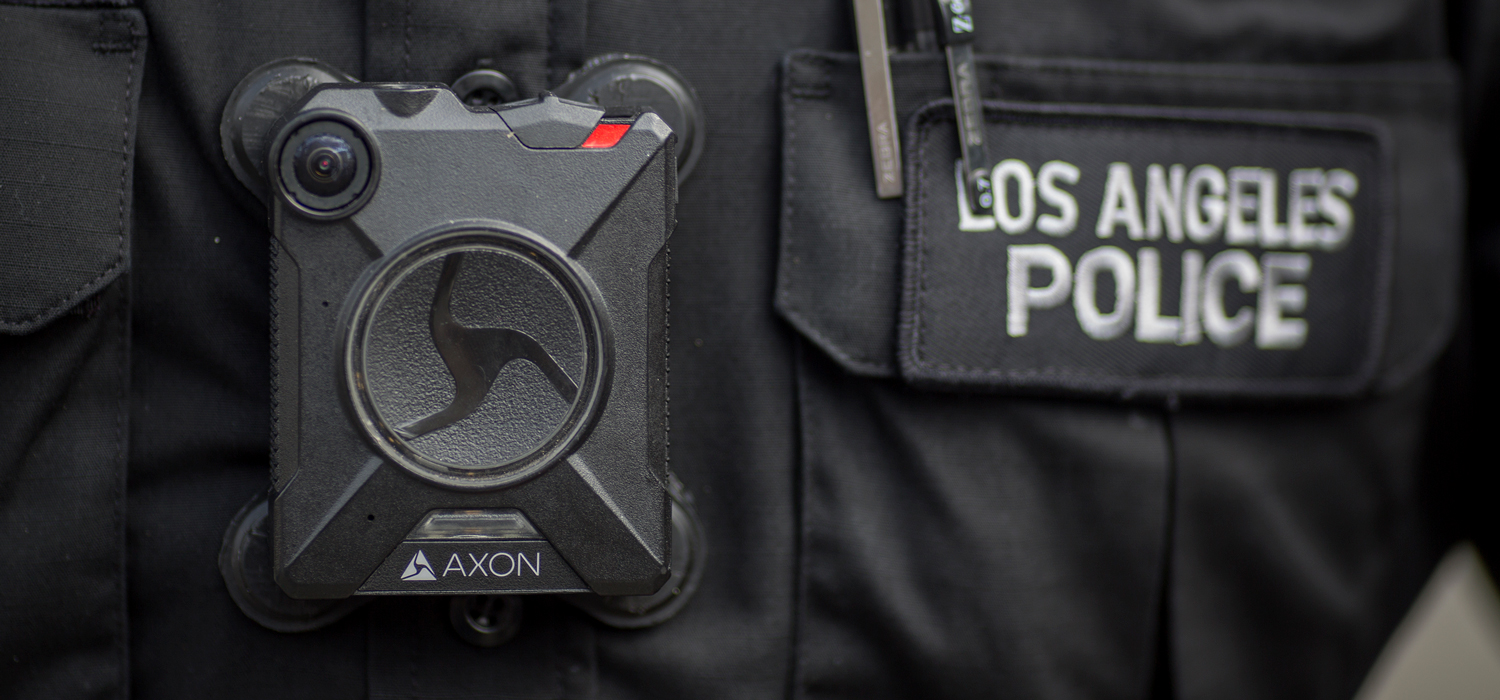
<p>A Los Angeles police officer wears an AXON body camera on February 18, 2017 in Los Angeles, California. Photo by David McNew/Getty Images.</p>
Last week, footage from police body cameras in two very different cases told a similar story: that body cameras are an increasingly necessary tool for transparency. But police departments still need to do more to improve transparency and accountability.
In one case, Milwaukee police officers stopped Sterling Brown, an NBA player for the Milwaukee Bucks, for a parking violation. After a verbal exchange, the officers wrestled Brown to the ground and tased him. Once footage of the incident was released, the officers involved were suspended.
In another incident, Sherita Dixon-Cole accused a Texas state trooper of sexually assaulting her during a DWI (driving while intoxicated) arrest and threatening to kill her fiancé if she told anyone about what happened. The events depicted in the officer’s body camera footage strongly contradict these claims.
The Sterling Brown incident struck a particular chord with me: my colleagues and I recently released a report summarizing findings from the Urban Institute’s evaluation of the Milwaukee Police Department’s body camera program.
We found that body cameras significantly reduced subject stops and citizen complaints but had no impact on the degree to which Milwaukee officers used force during their interactions with community members.
Our report, and other studies with similar findings, suggest that body cameras alone cannot fix long-strained police-community relationships. Despite the growing use of body cameras, some officers act inappropriately or use excessive force, while some community members lodge unnecessary or false complaints against officers who follow the law and behave professionally.
But these cases also demonstrate that this policing technology can further an important goal: improving transparency and accountability. Body cameras documented both incidents and led to the discipline or vindication of the officers involved. Still, these recent cases—and our research—emphasize three strategies for maximizing body camera transparency.
- Police administrators must ensure their officers comply with departmental policies regarding camera activation and use. Most departments mandate that officers activate their body cameras during every encounter with the public. But compliance rates are often low, with some officers activating their cameras in fewer than 2 percent of incidents. While new technologies may improve officer compliance—such as cameras that automatically turn on when calls are dispatched or weapons are drawn—departments must do a better job of tracking compliance and addressing it when officers aren’t following protocols.
- Officers must notify the people they contact when their body cameras are recording. In Milwaukee and many other police departments, policies suggest—but do not mandate—that officers tell community members when their cameras are activated and recording. As a result, few people are actually aware of cameras during their encounters with police. Perhaps Dixon-Cole would have chosen not to lodge her false allegations had she realized the incident was being captured.
- Departments should work as quickly as possible to release body camera footage from high-profile incidents and other incidents upon request. In most states, the public can access footage through open records requests. But this process can be delayed when the footage is part of an ongoing investigation or when it contains details (like faces, license plates, or private information) that must be redacted before release.
The Sterling Brown incident occurred nearly four months before the body camera video was released, pending the Milwaukee Police Department’s internal investigation of use of force. Another analysis found that videos from only 65 of 105 fatal police shootings captured on body cameras in 2017 were made public, with nearly half released a month or more after the incident.
Although it is important for departments to follow due process and have fair investigations, fully achieving transparency requires balancing these needs with the ability to consistently release footage within a reasonable time frame.
Body camera footage provides critical evidence for internal and external investigations of police conduct and offers community members a detailed, firsthand account of what happened during an encounter. It is no surprise, then, that body cameras have widespread support from both the public and police officers and appear poised to become a standard in police practice.
By following these three recommendations, police departments are primed to enhance the transparency and accountability of their body camera programs.
Let’s build a future where everyone, everywhere has the opportunity and power to thrive
Urban is more determined than ever to partner with changemakers to unlock opportunities that give people across the country a fair shot at reaching their fullest potential. Invest in Urban to power this type of work.